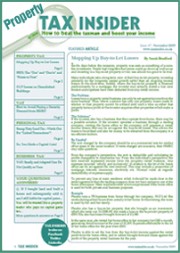 This is the second article in a series looking at different business structures that can be used by investors in buy to let properties, and deals with using a limited company.
This is the second article in a series looking at different business structures that can be used by investors in buy to let properties, and deals with using a limited company.
A limited company is owned by its shareholders, but it is a separate legal entity and can make contracts, be sued, and pay tax in its own right, unlike a partnership which is “transparent” – meaning that it is the individual partners, not the partnership itself, that pays tax.
Tax has often been the main incentive to set up a limited company. Whereas an individual (or a partner in a partnership) will pay income tax at 20%, 40%, or even 50% on their share of the business profits, a limited company pays corporation tax on its profits. The rate of corporation tax is currently 20% on the first £300,000 of profits, rising after that to a maximum rate of 26% on profits over £1.5 million.
For the vast majority of property businesses, then, the rate of tax will be 20%. It must however be remembered that once this tax has been paid, the remaining cash still belongs to the company, and in order to extract it for the use of the shareholders, there will be a further tax cost. There are several ways to extract cash from a company, and in the case of a shareholder with no other income, it is possible for the company to pay him (say) a salary of £7,475 and dividends of £31,500, with no liability to income tax. A married couple, therefore, can extract up to £77,950 from their limited company with no further tax charge. This still leaves them marginally worse off than if they had simply paid income tax on the original rental income, so where is the tax saving?
Companies really save tax where they retain some of their profits to reinvest in the business. An individual landlord has to pay tax on the whole of his rental profit, whether he leaves it in the business or draws it out to spend on his living expenses. But with a limited company, the shareholders can choose how much they pay out, and the profits they leave in the company will only suffer tax at 20%.
The word “limited” refers to the “limited liability” of the company’s shareholders. If the business goes broke, the worst that can happen is that their shares become worthless, whereas an individual or a partner in a partnership can be forced to sell his own possessions, such as his home, if this becomes necessary to meet the business debts.
Limited liability may sound good, but the reality is that most shareholders of limited companies will find that their liability is rather less limited than this. For example, if the company wants to borrow money, the lender may well insist on “personal guarantees” from the shareholders, where they effectively put their own assets up as security for the loan to the company.
A limited company is also required to file its accounts with Companies House each year, and these accounts are public information which anyone can access by paying a small fee to Companies House.
Practical Tip
The need to file these accounts means that a limited company will have to use the services of an accountant to prepare the accounts in the proper form, and file them using specialist software known as iXBRL, all of which comes with a cost. Although I would certainly not recommend that an individual landlord or a partnership do their own accounts and tax returns, an accountant will have to charge more for doing company accounts, due to the extra layers of bureaucracy and complexity involved.
In the last of this series of articles, we will look at a comparatively new business structure which many see as the ideal compromise between individual investment and using a limited company – the limited liability partnership.
This is a sample article from the monthly Property Tax Insider magazine. Go here to get your first free issue of Property Tax Insider.
 This is the second article in a series looking at different business structures that can be used by investors in buy to let properties, and deals with using a limited company.
This is the second article in a series looking at different business structures that can be used by investors in buy to let properties, and deals with using a limited company.

 Tax Articles
Tax Articles